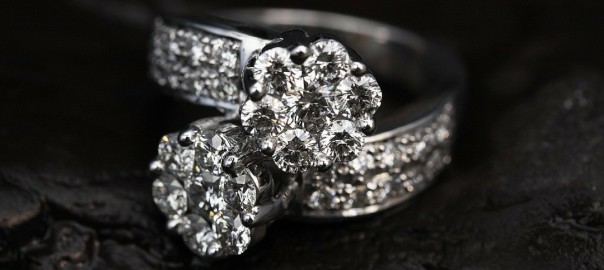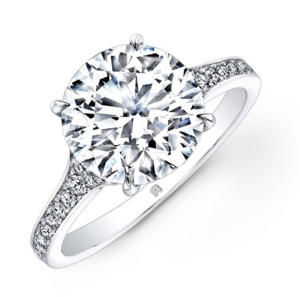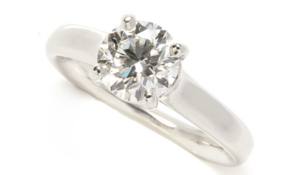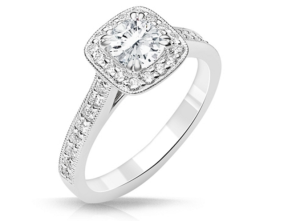Engagement Ring Mounting Guide

So, you’ve chosen the perfect diamond for your engagement ring – now you need to display it! That is where the ring setting or engagement ring mounting comes into play. There are a few things to consider before selecting your engagement ring mounting design:
Engagement Ring Mounting Considerations
One – where or when will the ring be worn the most? If someone has a job where they are in and out of latex gloves, you might consider a mounting where the diamond sits a bit lower, like our Claire or Charlize engagement ring designs.
Two – what type of metal should be used? Platinum? Gold? What’s the difference? Some people are allergic to the alloys (like silver, nickel or zinc) which are added to gold to make it more durable for jewelry. Therefore, designing a ring in platinum would be recommended. Additionally, if you are going with a “white” metal for your ring, then platinum will always stay white; where as white gold, after 5-10 plus years or so, will need to be rhodium plated as the nickel, zinc and/or silver begins to wear through. It’s not a big deal to have this done, and fairly inexpensive.
Three – what is your budget? You’ve spent most of the budget on the center stone, but a plain 14K rose, white or yellow gold mounting is $500. Obviously, the more detail that you add the price will increase.
Design Preference – Engagement Ring Mounting
After that, it’s all about personal preference in the design. When you think about it, there are really only four ring styles – solitaire, solitaire-plus, halo and three-stone. Creating a ring that is unique from the other is about other choices like how you want the diamond to sit on the ring itself, and do you want additional diamonds around the center stone (which creates the halo style) and/or on the ring band itself. And if you do elect for diamonds on the sides, should they be formed as a split shank (V-shape) or tapper up to the diamond, or maybe they should be set in channel or bar style, etc.
Here is a brief explanation of ways to mount the diamond, the different rings styles and designs:
DIAMOND MOUNTING / HOW THE DIAMOND IS HELD ON/IN THE RING
- 4-Prong … this is how most diamonds are mounted; look closely at our SK Solitaire ring and notice the prongs.
- 6-Prong … this creates a more star-like appearance and is more secure. Usually seen only with solitaires.
- Bezel Set … this is where metal is surrounding or partially surround the diamond. This gives the ring a more modern appearance.
- Tension Set … where the diamond is held by the pressure the metal of the band. While these are super cool, they are very difficult to size because of the exact engineering behind the metal holding the diamond in place.

BASIC RING STYLES
- The SOLITAIRE Engagement Ring – This style continues to be the most popular choice because of its simplicity, and ability to pair perfectly with most wedding bands. With the solitaire, it is one diamond mounted on a ring with 4 or 6 prongs, or bezel-set or tension set. If you are looking to create a unique look to your solitaire, choose a mounting that has more detailed design in the metal. But a word to the wise, do have a wedding band created to match your special engagement ring to ensure the rings fit together properly.
- The SOLITAIRE-PLUS Engagement Ring – This is one diamond but has added diamonds on the sides that either tapper up shown here or have a split shank as seen here.
- The HALO Engagement Ring – This is one diamond surrounded by a crown of smaller diamonds, creating the illusion of a larger looking center stone. This is great choice if you are selecting a smaller stone for the center. The Halo looks great on a plain metal ring or one ornate with diamonds.
- The 3-STONE Engagement Ring – This ring literally has three stones that represent the past, present and future. The center stone is typically bigger than the two side stones. Note, if you want to make this ring more unique, consider a blue sapphire or ruby as your center stone.
DIAMONDS ON THE SIDE ALONG THE RING BAND
- BEZEL SET – all diamonds are enclosed with medal surrounding them – historically, this was how much of jewelry was designed. So, if you are looking for a more vintage style, our Henley engagement ring is for you.
- CHANNEL SET – Brides next most popular ring choice is a channel set engagement ring. Just as the name implies, it’s a channel of diamonds that sit into the metal of ring. These rings make great wedding band as well.
- BAR SET – Is a bit opposite from the channel set, in that a BAR of vertical metal is between the diamonds, where the diamond is only exposed on the outside edge of the ring. This looks great with Ascher or Emerald cut center stones.
- U-SET / PRONG SET – are variations of setting exposed diamonds along the band, so all you really see is diamonds.
- PAVÉ – Jewelers “pave” the ring with diamonds. The pave setting “pa-vay” closely sets smaller diamonds with small metal beads or prongs to create a continuous sparkle. This magnifies the overall brilliance as well as the center stones presence.
If you are choosing an engagement ring mounting with diamonds on the sides of the band, we strongly encourage you to also have a matching wedding band created at the same time, so that you are sure to have all the diamonds matching in color, size, and quality. Your fiancé will have to relinquish her engagement ring for a week to ensure all the stones match and line-up.
At Schwanke-Kasten Jewelers, we carry a full range of GIA certified diamonds and can help you choose or customize the perfect engagement ring mounting. Stop in or set-up an appointment to visit us at our Whitefish Bay or downtown Milwaukee location.

